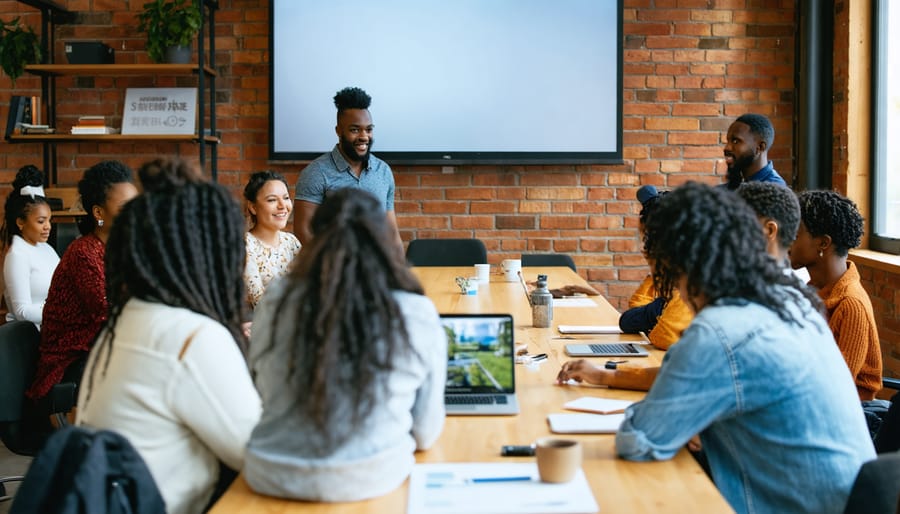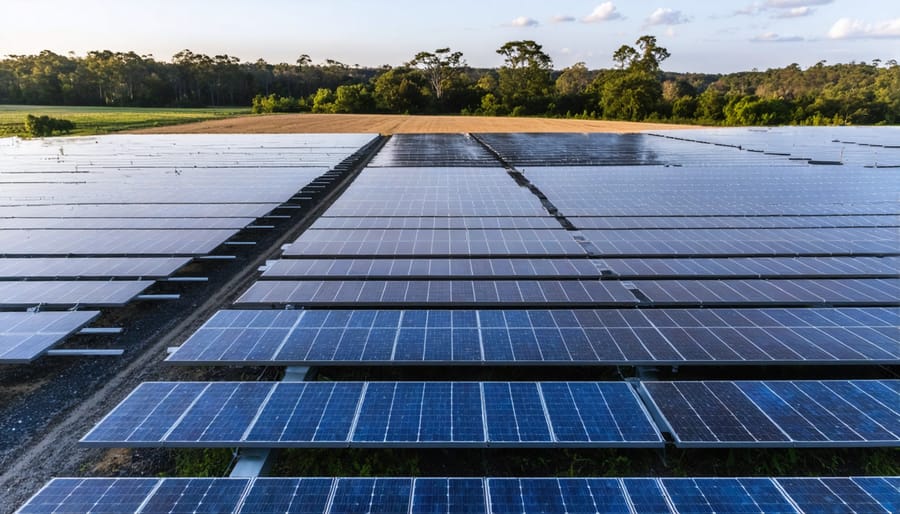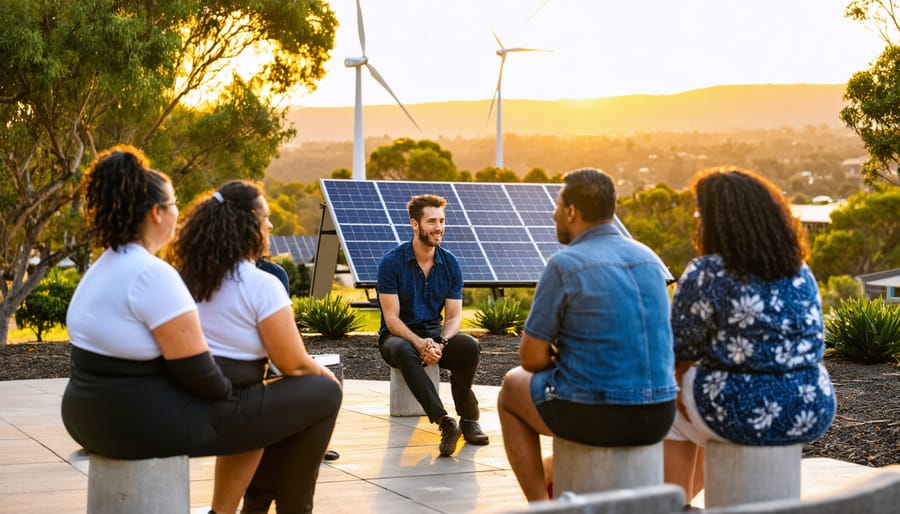**Green advocacy transforms communities.** Across Australia, everyday citizens are reshaping renewable energy policy—not through grand gestures, but through strategic, persistent action that amplifies their collective voice. When Melbourne’s Inner West Climate Action Group successfully lobbied their council to commit to 100% renewable energy by 2030, they demonstrated what focused community advocacy achieves: tangible policy change that accelerates our clean energy transition.
**Your voice matters more than you think.** Policymakers consistently report that coordinated community advocacy influences their decisions far more than individual expertise or industry lobbying. The difference lies in sustained pressure, strategic messaging, and building coalitions that make renewable energy transitions politically irresistible.
**Starting feels daunting—it doesn’t need to be.** Successful green advocacy projects follow proven patterns: they identify specific, achievable policy targets; they build diverse coalitions connecting environmental groups with local businesses and community organizations; and they create compelling narratives that connect renewable energy benefits to what locals genuinely care about—job creation, energy affordability, and community resilience.
This guide reveals the practical strategies behind Australia’s most successful renewable energy advocacy campaigns. You’ll discover how small groups create disproportionate impact, which tactics move policymakers from resistance to enthusiasm, and the step-by-step roadmap for launching your own advocacy project. Whether you’re passionate about bioenergy, solar, wind, or comprehensive renewable transitions, these principles work. **The question isn’t whether advocacy creates change—it’s whether you’re ready to be part of it.**
What Makes Community-Driven Energy Advocacy Different
Community-driven energy advocacy operates on a fundamentally different engine than traditional top-down approaches. When local residents band together to champion renewable energy solutions, they bring something corporations and government departments simply can’t replicate: authentic, lived experience of their community’s needs and aspirations.
The power lies in the personal. A neighbor speaking about solar potential on their street carries more weight than any corporate presentation. When Mrs. Chen from Bankstown or Dave from Bendigo shares their renewable energy journey at a council meeting, decision-makers listen differently. These aren’t lobbyists with financial interests—they’re constituents with genuine stakes in their community’s future.
Grassroots movements also move with remarkable agility. While large organizations navigate bureaucratic processes, community groups can pivot quickly, test innovative approaches, and respond to local opportunities as they arise. The community-driven renewable energy initiatives springing up across Australia demonstrate this nimbleness beautifully—from regional towns establishing solar farms to suburban neighborhoods creating energy-sharing schemes.
Perhaps most importantly, community advocacy builds lasting momentum. Corporate campaigns end when budgets dry up. Government programs shift with political winds. But communities persist because they’re fighting for their backyards, their children’s futures, and their energy bills.
This bottom-up approach creates authentic pressure that policymakers find hard to dismiss. When constituents organize, attend meetings, and speak with one united voice, they transform abstract policy debates into urgent local priorities. Australian councils and state governments have increasingly responded to this grassroots pressure, proving that change doesn’t always require corporate backing or government initiative—sometimes it just needs passionate locals who refuse to stay quiet.

Building Your Green Advocacy Project from the Ground Up
Finding Your Community’s Energy Pain Points
Every successful green advocacy project starts with understanding what keeps your community awake at night—or what should. Rather than assuming you know the answers, roll up your sleeves and do some detective work. Start by chatting with neighbours at the local café, attending council meetings, or organising a casual community barbecue where energy concerns naturally bubble to the surface.
Look for the telltale signs of energy struggles in your area. Are power bills becoming a major topic of conversation? Has a recent blackout left people worried about reliability? Perhaps local businesses are frustrated by rising operational costs, or perhaps there’s excitement about a new development that could benefit from renewable solutions.
Create simple surveys—even a Google Form shared on community Facebook groups works brilliantly—asking residents about their energy concerns, awareness of renewable options, and what would motivate them to support clean energy initiatives. Visit local schools, sporting clubs, and community centres to understand their energy challenges firsthand.
Don’t forget to tap into existing data. Your local council’s energy reports, Australian Energy Market Operator statistics for your region, and state government renewable energy roadmaps provide valuable context. However, remember that real stories trump statistics every time. When Mrs. Chen from down the road shares how solar panels halved her electricity bills, that’s gold for your advocacy efforts.
The goal isn’t finding problems—it’s discovering opportunities where renewable energy solutions can genuinely improve lives whilst building a cleaner future together.
Assembling Your Core Advocacy Team
Building an effective advocacy team starts with recognising that environmental change happens when diverse voices unite around a shared vision. Your core team should reflect the community you’re serving – think local business owners passionate about clean energy, retired engineers with technical expertise, teachers who can simplify complex concepts, and young people bringing fresh perspectives and digital savvy.
Start by mapping your community’s strengths. Who’s already championing sustainability in their workplace? Which local leaders have established networks? In regional Queensland, a successful bioenergy advocacy group brought together a dairy farmer, a council member, and a communications specialist – each contributing unique insights that made their campaign resonate with different audiences.
Establish clear roles early on. You’ll need someone coordinating activities, another person managing community outreach, and team members focused on research and policy analysis. Don’t overlook the power of storytellers – someone who can transform technical renewable energy benefits into compelling narratives that move people to action.
Remember, advocacy isn’t about having all the answers from day one. It’s about gathering people who share your commitment to a cleaner future and are willing to learn together. Schedule regular check-ins, celebrate small wins, and remain open to welcoming new members as your project grows. The strongest teams evolve naturally, drawing strength from their collective passion for environmental progress.

Creating a Clear, Actionable Vision
Every successful green advocacy project starts with crystal-clear goals that you can actually measure and achieve. Rather than vague aspirations like “support renewables,” effective campaigns set specific targets: “Secure council commitment to 50% renewable energy by 2027” or “Achieve 500 household solar installations within 12 months.”
Take inspiration from Solar Citizens, whose “Powering a Prosperous Future” campaign achieved remarkable wins across Australia. They didn’t just advocate for “more solar”—they pushed for concrete policy changes, successfully defending the Renewable Energy Target and protecting feed-in tariffs that benefit thousands of Aussie households. Their secret? Breaking big visions into measurable milestones.
The Community Power Agency provides another brilliant example. They helped establish specific renewable energy targets for local councils, with clear timelines and accountability measures. When Darebin Council committed to zero net emissions by 2028, it wasn’t just feel-good rhetoric—it came with detailed action plans and progress indicators.
Your advocacy vision should answer three questions: What exactly do you want? When do you want it? How will you know you’ve succeeded? This clarity transforms passionate concern into strategic action, making it easier to rally supporters, convince decision-makers, and celebrate genuine progress along the way.
Success Stories: Communities That Changed the Game

How a Regional Town Secured Solar Farm Approval
When the rural town of Dubbo in central-west New South Wales decided to champion a 20-megawatt solar farm in 2019, locals knew they’d face hurdles. The proposed site sat on grazing land that had supported the community for generations, making some residents understandably nervous about the transition.
The turning point came when a group of farmers, business owners, and concerned citizens formed the Dubbo Solar Advocacy Alliance. Rather than approaching the project as outsiders versus locals, they focused on education and inclusion. They organised town hall meetings where solar energy experts explained how the farm would create jobs during construction, generate ongoing maintenance positions, and provide stable lease income to participating landowners.
One particularly clever move was partnering with nearby schools to demonstrate solar technology’s benefits firsthand. Students visited operational solar facilities, learning how community solar initiatives were already powering other regional towns successfully.
The biggest obstacle emerged during council meetings, where concerns about visual impact and property values dominated discussions. The advocacy group responded with data from similar projects across regional Australia, showing property values remained stable or increased near well-maintained solar installations.
After eighteen months of persistent community engagement, transparent communication, and addressing every concern with facts rather than dismissiveness, Dubbo’s solar farm received unanimous council approval in late 2020. Today, the facility powers over 9,000 homes and has become a source of genuine community pride, proving that grassroots advocacy grounded in respect and education can transform renewable energy from a contentious issue into a shared achievement.
The Coastal Community That Blocked Fossil Fuel Expansion
When the Victorian coastal town of Westernport Bay learned that a major gas import terminal was planned for their waters in 2017, residents refused to accept it as inevitable. Local families, fishers, and environmental groups formed a coalition that would ultimately block one of Australia’s largest proposed fossil fuel projects.
The community’s approach was methodical and inclusive. They organised beach clean-ups that doubled as information sessions, created a social media campaign showcasing the bay’s biodiversity, and collected over 17,000 public submissions opposing the development. Critically, they didn’t just say “no” to gas—they presented a compelling alternative, commissioning independent research demonstrating how renewable energy investments could meet the region’s needs whilst creating more jobs than the proposed terminal.
Their persistence paid off. In 2021, after four years of sustained advocacy, the energy company withdrew its proposal. The Victorian Government subsequently announced funding for renewable energy projects in the region, including community solar initiatives and battery storage facilities.
The key lessons from Westernport resonate beyond Victoria. First, offering viable alternatives is more powerful than opposition alone. Second, building broad coalitions—from surfers to business owners—creates political pressure that’s hard to ignore. Third, local knowledge matters; residents documented marine life and economic impacts with a detail that corporate consultants missed.
This wasn’t just about stopping infrastructure; it was about redirecting investment toward a cleaner future. Today, Westernport Bay stands as proof that grassroots advocacy can reshape energy policy when communities unite around both opposition and opportunity.
Effective Tactics for Influencing Policy Makers
Speaking Their Language: What Policymakers Actually Want to Hear
Policymakers respond to language that speaks directly to their priorities: economic growth, job security, and community wellbeing. When advocating for renewable energy projects, lead with the dollars-and-cents benefits rather than environmental concerns alone. Frame your pitch around how solar farms create local employment, how wind energy stabilises electricity costs for households, and how bioenergy projects can transform agricultural waste into revenue streams for regional communities.
Take inspiration from successful advocacy in regional Queensland, where community groups secured support for a biomass facility by emphasising it would create 45 ongoing jobs while solving the district’s crop residue disposal challenges. They presented clear financial projections showing reduced power bills for local businesses and positioned renewable energy as a practical economic solution, not just an environmental ideal.
Focus on tangible outcomes policymakers can champion: reduced energy costs for families doing it tough, new apprenticeships for young Australians, and enhanced energy security during extreme weather events. Share specific case studies from Australian communities that have already benefited from renewable projects—real stories about real people resonate far more powerfully than abstract climate data.
When discussing community safety, highlight how distributed renewable energy systems provide backup power during bushfire seasons and reduce vulnerability to supply disruptions. Frame your advocacy around protecting communities and building resilience, using language that reflects shared values like “fair go” energy access and strengthening regional Australia’s economic backbone.
Building Alliances Beyond the Usual Suspects
Effective green advocacy thrives when you look beyond the environmental movement’s traditional circles. Some of your most powerful allies might surprise you.
Rural farmers understand land stewardship intimately and increasingly recognise how renewable energy can diversify farm income. In regional Victoria, a group of wheat farmers partnered with environmental advocates to establish biomass energy facilities that convert crop waste into power—creating new revenue streams while reducing emissions. Start conversations by focusing on shared values like land preservation and economic resilience rather than leading with climate terminology.
Business owners concerned about energy costs and supply reliability often make natural partners. A hardware store owner in Toowoomba became a renewable energy champion after discovering solar installations could slash overheads. These allies bring credibility with audiences who might dismiss traditional environmental voices. Frame your advocacy around economic opportunity, energy independence, and community benefit.
Conservative community groups, sporting clubs, and faith organisations frequently prioritise local wellbeing and self-sufficiency—values that align perfectly with community-owned renewable projects. Energy cooperatives succeed by uniting diverse stakeholders around practical benefits rather than political positions.
The key is listening first. Understand what matters to potential partners, then demonstrate how renewable energy advances their priorities. When a coastal fishing cooperative in South Australia joined forces with environmentalists to oppose offshore drilling, they showed how unexpected alliances create unstoppable momentum. Your advocacy becomes exponentially stronger when it reflects your community’s full diversity.
Overcoming Common Roadblocks
Every advocacy group hits obstacles along the way, but understanding these challenges helps you navigate them with confidence rather than letting them derail your mission.
**Facing Down Opposition**
Fossil fuel interests often have deep pockets and established networks, which can feel intimidating. However, you’ve got something they don’t—genuine community passion and the momentum of global climate action. When facing organised opposition, focus on building coalitions with local businesses, schools, and community groups who benefit from renewable energy. Document your wins visibly: share photos of solar panels going up on community centres, celebrate reduced energy bills, and highlight local jobs created. In regional Queensland, one advocacy group successfully countered fossil fuel messaging by partnering with farmers who’d installed wind turbines, letting real people tell authentic stories about economic benefits.
**Breaking Through Apathy**
Community apathy often stems from feeling overwhelmed rather than actual disinterest. Combat this by making participation ridiculously easy. Instead of asking people to attend lengthy meetings, invite them to sign a single petition, share one social media post, or bring a plate to a renewable energy BBQ. Small actions build momentum. One Melbourne group cracked this by hosting “energy bill clinics” where volunteers helped neighbours understand their bills and find renewable alternatives—turning abstract climate concerns into immediate, practical savings.
**Navigating Funding Constraints**
Limited budgets needn’t limit impact. Start with zero-cost strategies: leverage free social media platforms, tap into existing community networks, and approach local councils for in-kind support like meeting spaces. Many Australian councils offer small grants for environmental initiatives—even $500 can print flyers and host an information session. Crowdfunding platforms have funded numerous grassroots campaigns, especially when you tell compelling stories with clear goals. Remember, volunteers are your greatest asset. A passionate team of five committed people often achieves more than a well-funded group lacking genuine enthusiasm.
Your Action Plan for the Next 90 Days
Ready to transform your environmental passion into real change? Here’s your practical roadmap to launch a green advocacy project that fits around your busy life.
**Weeks 1-4: Foundation Building**
Start by identifying your focus—whether it’s renewable energy in your community, bioenergy education, or policy change. Spend your first fortnight researching existing initiatives and connecting with like-minded locals through social media groups or council meetings. You’ll be surprised how many communities taking control of their energy future started with just a handful of passionate residents meeting over coffee. By week three, draft a simple one-page vision statement outlining your goals and why they matter locally. Week four is for gathering your core team—aim for 3-5 committed people who can dedicate even two hours weekly.
**Weeks 5-8: Building Momentum**
Now it’s time to go public. Create a simple social media presence and host your first community gathering—a BBQ or afternoon tea works brilliantly for relaxed conversations about renewable energy. During weeks six and seven, reach out to local councillors, businesses, and schools to understand their perspectives. Document one local success story that demonstrates what’s possible. Week eight focuses on planning your first campaign action, whether that’s a petition, letter-writing campaign, or information session.
**Weeks 9-12: Taking Action**
Launch your first initiative! Host your event, submit your proposal, or present to council. Celebrate small wins—every signature collected and conversation started matters. By week twelve, review what worked, acknowledge your team’s efforts, and map out your next quarterly goals. Remember, lasting change happens through consistent, achievable steps.
The journey toward a greener Australia doesn’t happen overnight, but it happens one voice, one conversation, one action at a time. Throughout this article, we’ve explored how ordinary Australians—from suburban parents to rural farmers—have transformed their concerns about climate change into powerful community movements that influence real policy change. These success stories prove that you don’t need to be a politician or a scientist to make a difference; you simply need to care enough to start.
Change can feel frustratingly slow, especially when you’re facing seemingly immovable systems or indifferent decision-makers. But remember that every major environmental victory in Australia’s history began with someone who decided that waiting wasn’t an option. The renewable energy targets we have today, the protection for precious ecosystems, the investment in bioenergy projects—all of these emerged from sustained community pressure and advocacy.
Your voice matters. Whether you’re attending your first council meeting, signing a petition, or organizing your neighbours for a community energy project, you’re contributing to a movement that’s reshaping Australia’s energy future. The beauty of green advocacy is that there’s no entry requirement except the willingness to participate.
So here’s your challenge: take one small step this week. Email your local MP about renewable energy. Join a community environmental group. Share a success story on social media. Start a conversation with a neighbour. That first step, however modest, is how every significant change begins. Australia’s sustainable future is waiting—and it starts with you.

